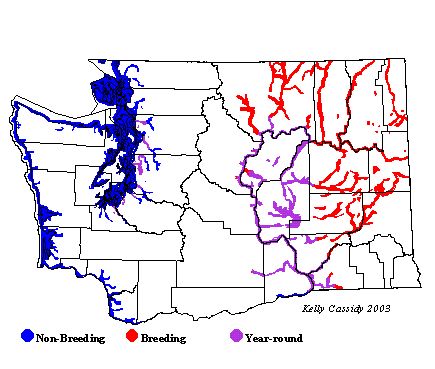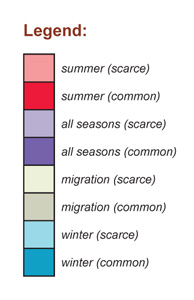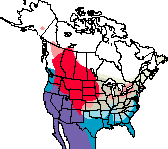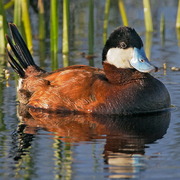Ruddy Duck
General Description
The Ruddy Duck is Washington's only representative of the stiff-tail ducks, known for holding their spiky tails up in the air. They have large, flat bills, small wings, and feet set far back on the body. The male Ruddy Duck is cinnamon in color overall with a black head, large, white cheek-patch, and bright blue bill. The male in non-breeding plumage has a mottled gray body and gray bill. The markings on the head are similar to those of breeding plumage. The female is mottled gray overall with black on the top of her head and a dark, horizontal line that bisects her white cheek. Her bill is gray. The juvenile is similar to the female, but the black on its face is less pronounced.
Habitat
In winter, Ruddy Ducks inhabit shallow, protected, saltwater bays and estuaries along the coast or ice-free, inland lakes and ponds. Breeding habitat is freshwater marshes and ponds with marshy borders mixed with open water.
Behavior
Ruddy Ducks are often found in tight flocks. They forage by diving under water and straining mud through their bills to find food. Like many small-winged ducks, Ruddy Ducks must get a running start across the water to become airborne.
Diet
Seeds and tubers from aquatic vegetation are a main staple of the Ruddy Duck's diet. Aquatic insect larvae are especially favored during the breeding season. Mollusks, crustaceans, and some small fish are also eaten.
Nesting
Pairs form after the birds have arrived on the breeding grounds. Nests are situated in dense marsh vegetation. The female builds a platform of grasses and cattails, lines it with down, and anchors it to emergent vegetation a few inches above the water. Many nests are concealed by vegetation pulled over the nest, which gives them a basket-shaped appearance. Sometimes the nest is built on top of an old muskrat house or bird's nest. The female lays 5 to 10 eggs (usually 8), and commonly lays eggs in the nests of other Ruddy Ducks or another species. The female incubates the eggs for 22 to 26 days. Within a day after hatching, the young leave the nest and can swim and dive well. They are tended by the female, but feed themselves. They first fly at 42 to 49 days.
Migration Status
Migration is drawn out over a long period in both spring and fall. The spring migration begins in late February, and continues through May. Males undergo a molt migration in July away from the breeding grounds before they head to the wintering grounds. The fall migration lasts from late August to November.
Conservation Status
The current population of Ruddy Ducks is apparently much lower than historical levels, mostly due to unrestricted hunting at the beginning of the 20th Century and to loss of nesting habitat. Christmas Bird Count data show a slight decline in Washington.
When and Where to Find in Washington
Ruddy Ducks are common in the summer at lower elevations in much of eastern Washington. Ruddy Ducks breed from the central Columbia Basin east through the Palouse and north along major river valleys in all the northern counties of eastern Washington. They are absent as a breeder west of the Columbia River in Chelan and Kittitas Counties as well as throughout most of western Yakima and Klickitat Counties. In western Washington, Ruddy Ducks breed uncommonly in the Puget Trough in King and Pierce Counties. They are abundant throughout the winter on open water. They are most common in the Strait of Juan de Fuca and Puget Sound, at major river estuaries, and locally along the Columbia River.
 Abundance
Abundance
| Ecoregion | Jan | Feb | Mar | Apr | May | Jun | Jul | Aug | Sep | Oct | Nov | Dec |
|---|---|---|---|---|---|---|---|---|---|---|---|---|
| Oceanic | ||||||||||||
| Pacific Northwest Coast | U | U | U | U | U | R | R | R | U | U | U | U |
| Puget Trough | C | C | C | C | F | U | U | U | U | F | C | C |
| North Cascades | ||||||||||||
| West Cascades | F | F | F | F | F | F | ||||||
| East Cascades | F | F | U | U | R | R | U | U | U | F | ||
| Okanogan | U | U | U | C | C | C | C | C | C | C | U | U |
| Canadian Rockies | U | F | F | F | F | F | F | U | ||||
| Blue Mountains | ||||||||||||
| Columbia Plateau | C | C | C | C | F | F | F | C | C | C | C | C |
Washington Range Map

North American Range Map


Family Members
 Fulvous Whistling-DuckDendrocygna bicolor
Fulvous Whistling-DuckDendrocygna bicolor Taiga Bean-GooseAnser fabalis
Taiga Bean-GooseAnser fabalis Greater White-fronted GooseAnser albifrons
Greater White-fronted GooseAnser albifrons Emperor GooseChen canagica
Emperor GooseChen canagica Snow GooseChen caerulescens
Snow GooseChen caerulescens Ross's GooseChen rossii
Ross's GooseChen rossii BrantBranta bernicla
BrantBranta bernicla Cackling GooseBranta hutchinsii
Cackling GooseBranta hutchinsii Canada GooseBranta canadensis
Canada GooseBranta canadensis Mute SwanCygnus olor
Mute SwanCygnus olor Trumpeter SwanCygnus buccinator
Trumpeter SwanCygnus buccinator Tundra SwanCygnus columbianus
Tundra SwanCygnus columbianus Wood DuckAix sponsa
Wood DuckAix sponsa GadwallAnas strepera
GadwallAnas strepera Falcated DuckAnas falcata
Falcated DuckAnas falcata Eurasian WigeonAnas penelope
Eurasian WigeonAnas penelope American WigeonAnas americana
American WigeonAnas americana American Black DuckAnas rubripes
American Black DuckAnas rubripes MallardAnas platyrhynchos
MallardAnas platyrhynchos Blue-winged TealAnas discors
Blue-winged TealAnas discors Cinnamon TealAnas cyanoptera
Cinnamon TealAnas cyanoptera Northern ShovelerAnas clypeata
Northern ShovelerAnas clypeata Northern PintailAnas acuta
Northern PintailAnas acuta GarganeyAnas querquedula
GarganeyAnas querquedula Baikal TealAnas formosa
Baikal TealAnas formosa Green-winged TealAnas crecca
Green-winged TealAnas crecca CanvasbackAythya valisineria
CanvasbackAythya valisineria RedheadAythya americana
RedheadAythya americana Ring-necked DuckAythya collaris
Ring-necked DuckAythya collaris Tufted DuckAythya fuligula
Tufted DuckAythya fuligula Greater ScaupAythya marila
Greater ScaupAythya marila Lesser ScaupAythya affinis
Lesser ScaupAythya affinis Steller's EiderPolysticta stelleri
Steller's EiderPolysticta stelleri King EiderSomateria spectabilis
King EiderSomateria spectabilis Common EiderSomateria mollissima
Common EiderSomateria mollissima Harlequin DuckHistrionicus histrionicus
Harlequin DuckHistrionicus histrionicus Surf ScoterMelanitta perspicillata
Surf ScoterMelanitta perspicillata White-winged ScoterMelanitta fusca
White-winged ScoterMelanitta fusca Black ScoterMelanitta nigra
Black ScoterMelanitta nigra Long-tailed DuckClangula hyemalis
Long-tailed DuckClangula hyemalis BuffleheadBucephala albeola
BuffleheadBucephala albeola Common GoldeneyeBucephala clangula
Common GoldeneyeBucephala clangula Barrow's GoldeneyeBucephala islandica
Barrow's GoldeneyeBucephala islandica SmewMergellus albellus
SmewMergellus albellus Hooded MerganserLophodytes cucullatus
Hooded MerganserLophodytes cucullatus Common MerganserMergus merganser
Common MerganserMergus merganser Red-breasted MerganserMergus serrator
Red-breasted MerganserMergus serrator Ruddy DuckOxyura jamaicensis
Ruddy DuckOxyura jamaicensis

